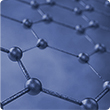| Ionic Industries Ltd |

| Registration Date | 10 Oct 2017 |
| Revision Date | 10 Oct 2017 |
| Share |
Environment Water and Wastewater
Water MembraneGraphene
C Graphene CAS Number : 7782-42-5
Graphene membranes can be tailored for the efficient and effective removal of a wide range of contaminants and materials from water or other liquids.
These qualities mean that our graphene nano-filtration membranes have broad potential in water treatment and mining applications.
Graphene membranes have a range of extraordinary properties that are likely to generate superior performance to current polymer-based technologies:
High chemical resistance making them safer and lower maintenance10 x higher flux than polymer membranes resulting in much greater efficiencyHigh mechanical strength for reduced maintenance and lifetime costTuneable selectivity during manufacture for precise customisation
Industrial scale membrane processes would require over hundreds of square meters of membrane area. To achieve this in an efficient manner (from the standpoints of cost and containment volume), membranes are packed into a housing known as a “module”, which can be retrofitted to existing membrane processes for trialling and evaluation with potential end-users. As a value-added product the membrane modules have higher business end-value than the membranes themselves, and we see this as key to exploiting the full value of our graphene membrane technology. Ionic is proposing to engage a global leader in membrane manufacturing for upscaling graphene membrane fabrication and development of membrane modules.Our graphene membranes program is well advanced as the milestones below highlight:
Research has been under way for 3 years.Research has been supported by an Australian Research Council industry linkage grant.Monash has filed a provisional patent application in Australia and has granted Ionic a Licence to the intellectual property the programme has generated.Ionic and Monash have the current capability to create 120 x 130 mm membranes.The production of membranes is a scalable process and Ionic is confident that the technology to create large graphene membranes is within reach.The Monash research team has also hit a further series of milestones in the development of graphene membranes and the technology is now assessed at Technology Readiness Level 4.
The research team has received international acclaim for its work on graphene membranes. In April 2015, Associate Professor Majumder presented his work on ‘Graphene-based fluidic systems: From compact micro/nano-fluidic devices to large area filtration membranes’ to the Royal Society London. The event, titled ‘Nanostructured carbon membranes for breakthrough filtration applications: advancing the science, engineering and design’, featured talks by the leading researchers on filtration from the UK, France, USA, Switzerland, Germany, South Korea and Australia.
The world’s oldest and most prestigious scientific society, presided over by the likes of Sir Isaac Newton and Sir Joseph Banks, The Royal Society is a world attention-calling platform for the important topics of the age. In this case, the concern was water purity and the way that carbon-based membranes can efficiently desalinate seawater and treat wastewater.